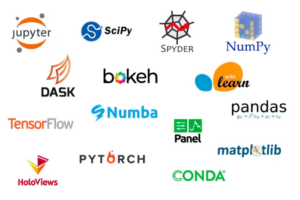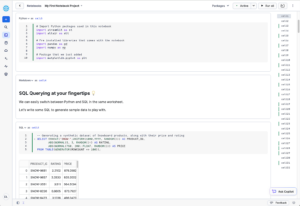
Anaconda Hooks Python, R Libraries Into Snowflake Data Science Notebook

Anaconda today announced support for Snowflake Notebooks, an interactive, cell-based data science notebook similar to Jupyter. The move will let data scientists, data analysts, and data engineers bring the full array of Python- and R-based machine learning, AI, and analytic libraries distributed by Anaconda to bear in Snowflake’s new data science notebook.
Snowflake unveiled Snowflake Notebooks at a Snowday event last November to give users a familiar notebook-style interface to write and run Python, SQL, and Markdown code that interacts with their Snowflake data, with all the features and security protections the Snowflake environment affords.
Currently in preview, Snowflake Notebooks gives users a centralized place for users to run exploratory data analysis, develop machine learning models, and perform data engineering tasks, while leveraging Notebooks’ native Git integration and scheduling to bolster consistency in data workflows.
Anaconda, meanwhile, maintains a repository of more than 8,000 open-source data science and machine learning packages, such as SciPy, NumPy, pandas, matplotlib, Dask, Juypter, Bokeh, scikitlearn, Conda, and thousands more. The Austin, Texas company does the work to ensure that these libraries are developed and compiled to run on all major operating systems and architectures.

Anaconda distributes more than 8,000 open source R and Python libraries for technical computing, data science, machine learning, visualization, data exploration, and analytics
Anaconda says its user base has grown to more than 43 million, an astonishing number that demonstrates the wide benefit that the company’s work has brought to the world of technical computing. By partnering with Snowflake and other data platforms, such as Teradata, IBM, and Oracle, Anaconda widens the reach of Python- and R-based machine learning, data visualization, and data engineering packages even more.
“The integration of Snowflake Notebooks with Anaconda represents a significant step forward in our mission to democratize Python and enable users to perform data science and AI tasks more efficiently,” Anaconda Chief AI & Innovation Officer Peter Wang stated in a press release. “By combining the robust capabilities of Anaconda with the innovative features of Snowflake Notebooks, we are empowering users to drive faster insights, streamline workflows, and unlock new opportunities for collaboration and innovation in their data science and AI projects all from the familiar Snowflake environment.”

Snowflake Notebooks, currently in preview, provides a cell-based interface for interactive data science exploration and development
Snowflake is working to broaden its usage and reach beyond data warehousing and processing SQL queries. Much of that work is occurring in Snowpark, which extended support for executing customer-supplied Python, Java, and Scala code in the Snowflake environment. Since Snowpark was introduced in June 2021 and made generally available in January 2022, it has become the hub for company’s efforts to attract data science and AI workloads.
Snowflake Notebooks, which runs in the Snowpark environment, further extends Snowflake’s push into data science, machine learning, and AI work. Thanks to the work Snowflake has done to pre-integrate its offerings, Snowflake Notebooks users can access the full array of AI and ML capabilities, including Snowpark ML, Streamlit, Cortex, and Iceberg tables.
And now that Anaconda’s extensive library of ML and AI libraries are approved for use in Snowflake Notebooks, data scientists and AI developers can leverage all of these capabilities together to explore data, build new ML models, and create data products without leaving the Snowflake environment.
“With Snowflake Notebooks, we’ve simplified the experimentation process for developers to iterate on their machine learning pipelines, harness AI-powered editing features, and streamline data engineering workflows in a style that’s familiar, intuitive, and powerful,” Snowflake’s Streamlit COO Amanda Kelly stated in a press release. “Through this integration with Anaconda, we’re going even further to accelerate data analysis, development, and collaboration for developers at the cutting edge of innovation.”
Related Items:
Snowflake Gives Cloud Customers What They Need and Want at Summit 2024
Anaconda Rejiggers Approach to Boost Growth Under New CEO
It’s a Snowday! Here’s the New Stuff Snowflake Is Giving Customers



























